Leading and Managing Change: An IBM Case Study for Business Students
VerifiedAdded on 2022/12/27
|9
|2335
|49
Report
AI Summary
This report presents a comprehensive analysis of IBM's change management strategies, focusing on the application of the Change Kaleidoscope model. The study examines the implementation of changes under Louis Vincent Gestner, highlighting the contextual factors such as time, scope, preservation, diversity, capability, capacity, readiness, and power. The report delves into the inner workings of the Kaleidoscope model, analyzing change paths, start points, styles, interventions, and roles. It assesses the effectiveness of Gestner's autocratic leadership style and the impact of cost-cutting measures, including workforce reductions and reward management strategies. The conclusion emphasizes the importance of employee involvement and effective leadership in driving successful organizational change, offering valuable insights for students of business management. The report is a detailed examination of IBM's transformation and its relevance to change management principles.
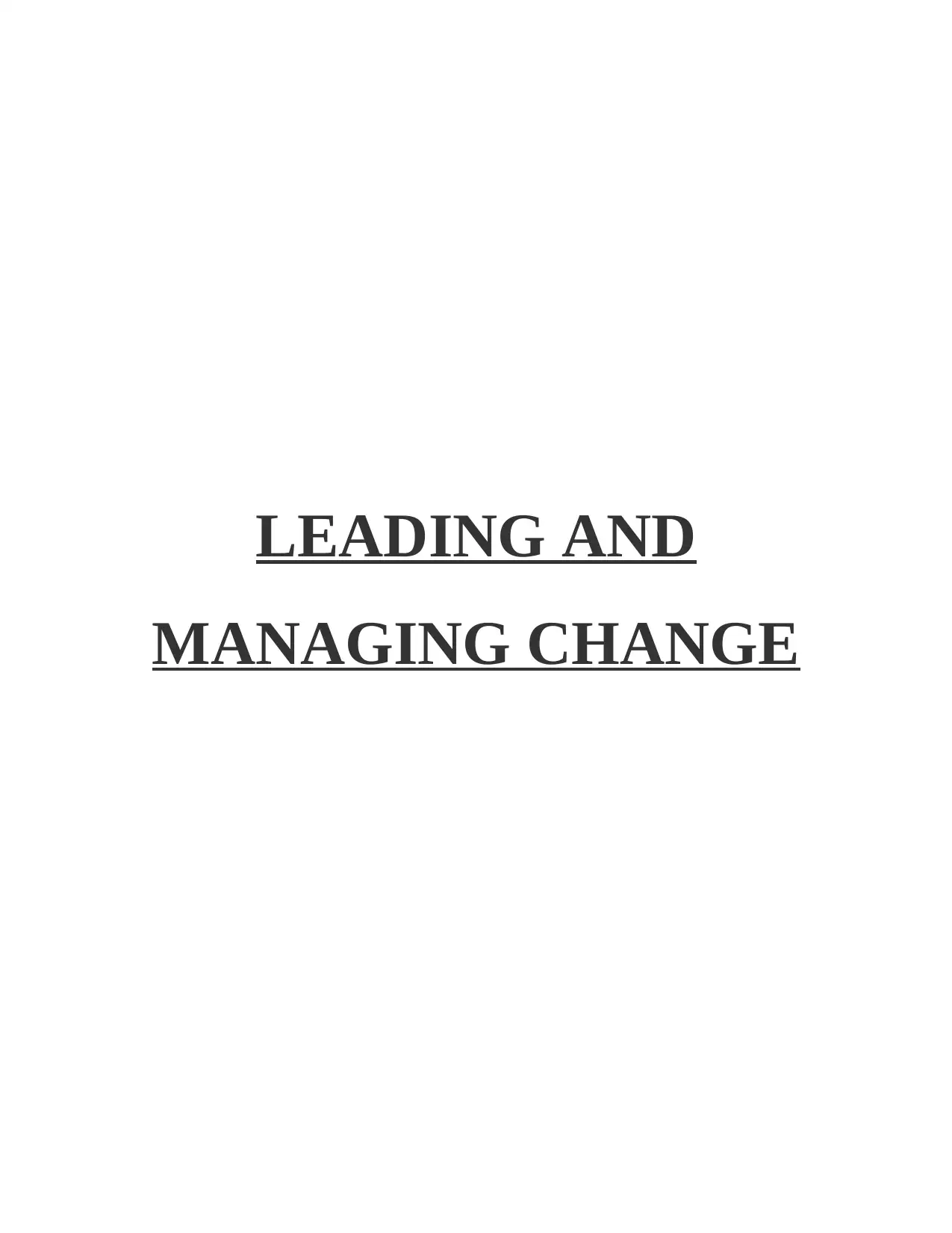
LEADING AND
MANAGING CHANGE
MANAGING CHANGE
Paraphrase This Document
Need a fresh take? Get an instant paraphrase of this document with our AI Paraphraser
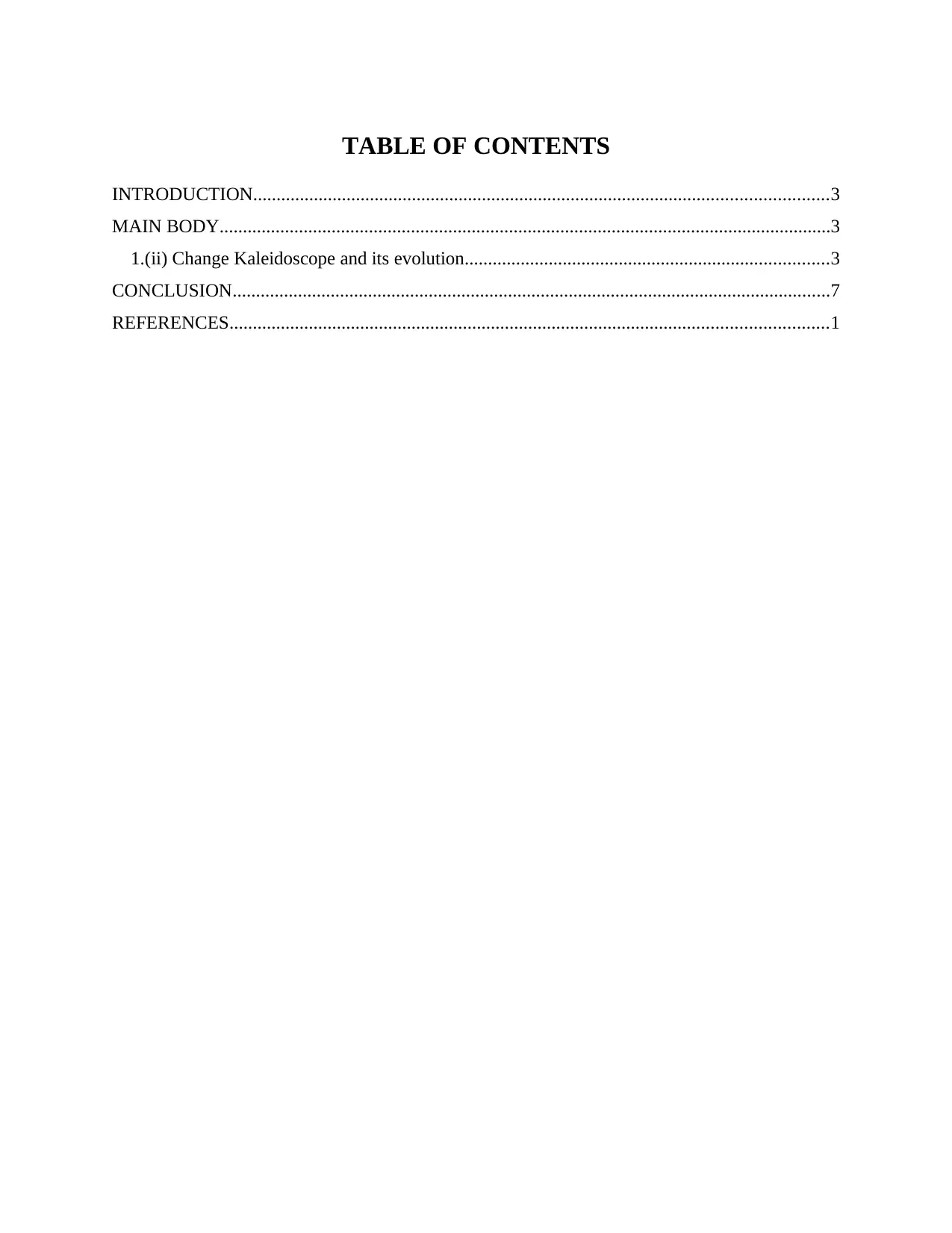
TABLE OF CONTENTS
INTRODUCTION...........................................................................................................................3
MAIN BODY...................................................................................................................................3
1.(ii) Change Kaleidoscope and its evolution..............................................................................3
CONCLUSION................................................................................................................................7
REFERENCES................................................................................................................................1
INTRODUCTION...........................................................................................................................3
MAIN BODY...................................................................................................................................3
1.(ii) Change Kaleidoscope and its evolution..............................................................................3
CONCLUSION................................................................................................................................7
REFERENCES................................................................................................................................1
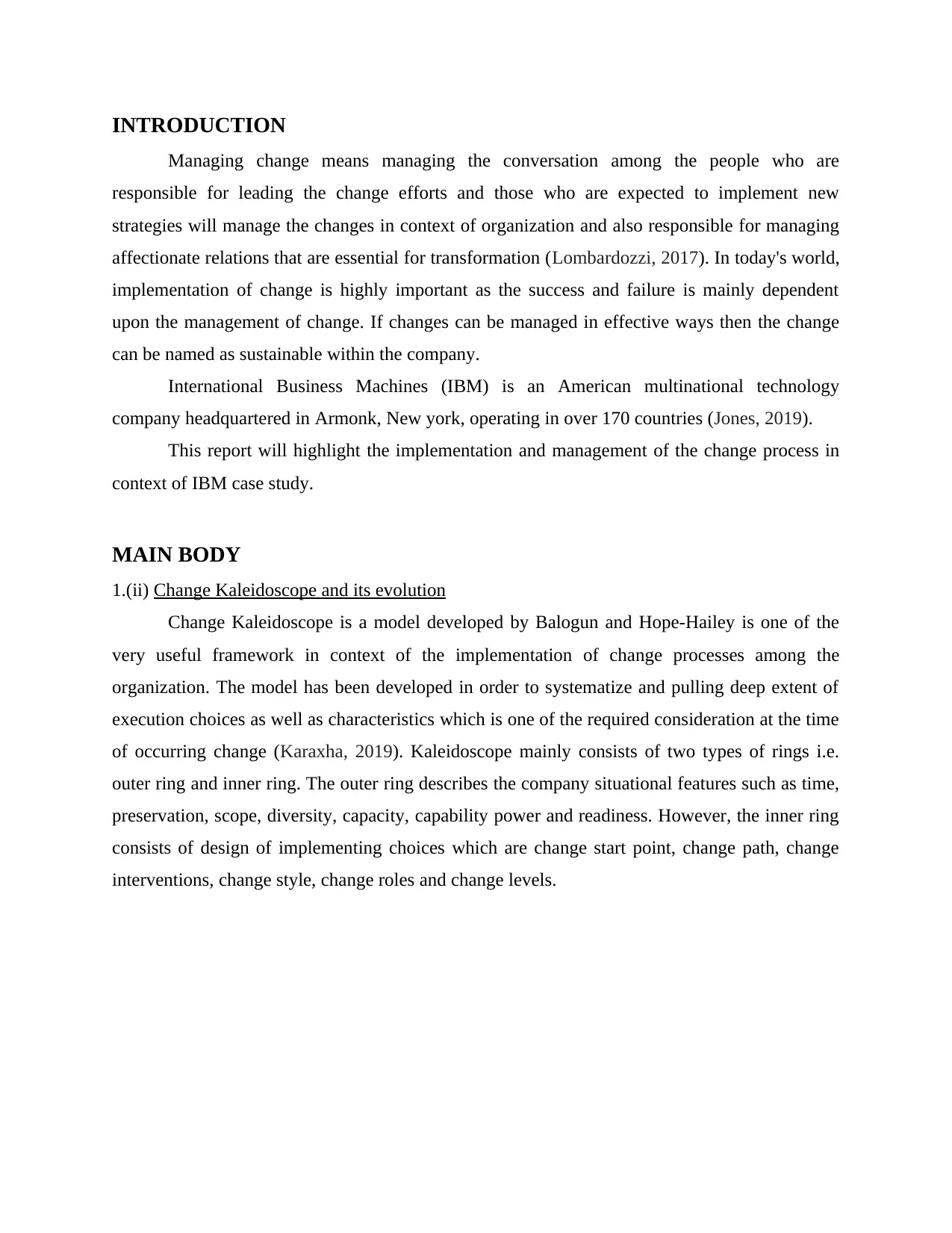
INTRODUCTION
Managing change means managing the conversation among the people who are
responsible for leading the change efforts and those who are expected to implement new
strategies will manage the changes in context of organization and also responsible for managing
affectionate relations that are essential for transformation (Lombardozzi, 2017). In today's world,
implementation of change is highly important as the success and failure is mainly dependent
upon the management of change. If changes can be managed in effective ways then the change
can be named as sustainable within the company.
International Business Machines (IBM) is an American multinational technology
company headquartered in Armonk, New york, operating in over 170 countries (Jones, 2019).
This report will highlight the implementation and management of the change process in
context of IBM case study.
MAIN BODY
1.(ii) Change Kaleidoscope and its evolution
Change Kaleidoscope is a model developed by Balogun and Hope-Hailey is one of the
very useful framework in context of the implementation of change processes among the
organization. The model has been developed in order to systematize and pulling deep extent of
execution choices as well as characteristics which is one of the required consideration at the time
of occurring change (Karaxha, 2019). Kaleidoscope mainly consists of two types of rings i.e.
outer ring and inner ring. The outer ring describes the company situational features such as time,
preservation, scope, diversity, capacity, capability power and readiness. However, the inner ring
consists of design of implementing choices which are change start point, change path, change
interventions, change style, change roles and change levels.
Managing change means managing the conversation among the people who are
responsible for leading the change efforts and those who are expected to implement new
strategies will manage the changes in context of organization and also responsible for managing
affectionate relations that are essential for transformation (Lombardozzi, 2017). In today's world,
implementation of change is highly important as the success and failure is mainly dependent
upon the management of change. If changes can be managed in effective ways then the change
can be named as sustainable within the company.
International Business Machines (IBM) is an American multinational technology
company headquartered in Armonk, New york, operating in over 170 countries (Jones, 2019).
This report will highlight the implementation and management of the change process in
context of IBM case study.
MAIN BODY
1.(ii) Change Kaleidoscope and its evolution
Change Kaleidoscope is a model developed by Balogun and Hope-Hailey is one of the
very useful framework in context of the implementation of change processes among the
organization. The model has been developed in order to systematize and pulling deep extent of
execution choices as well as characteristics which is one of the required consideration at the time
of occurring change (Karaxha, 2019). Kaleidoscope mainly consists of two types of rings i.e.
outer ring and inner ring. The outer ring describes the company situational features such as time,
preservation, scope, diversity, capacity, capability power and readiness. However, the inner ring
consists of design of implementing choices which are change start point, change path, change
interventions, change style, change roles and change levels.
⊘ This is a preview!⊘
Do you want full access?
Subscribe today to unlock all pages.

Trusted by 1+ million students worldwide
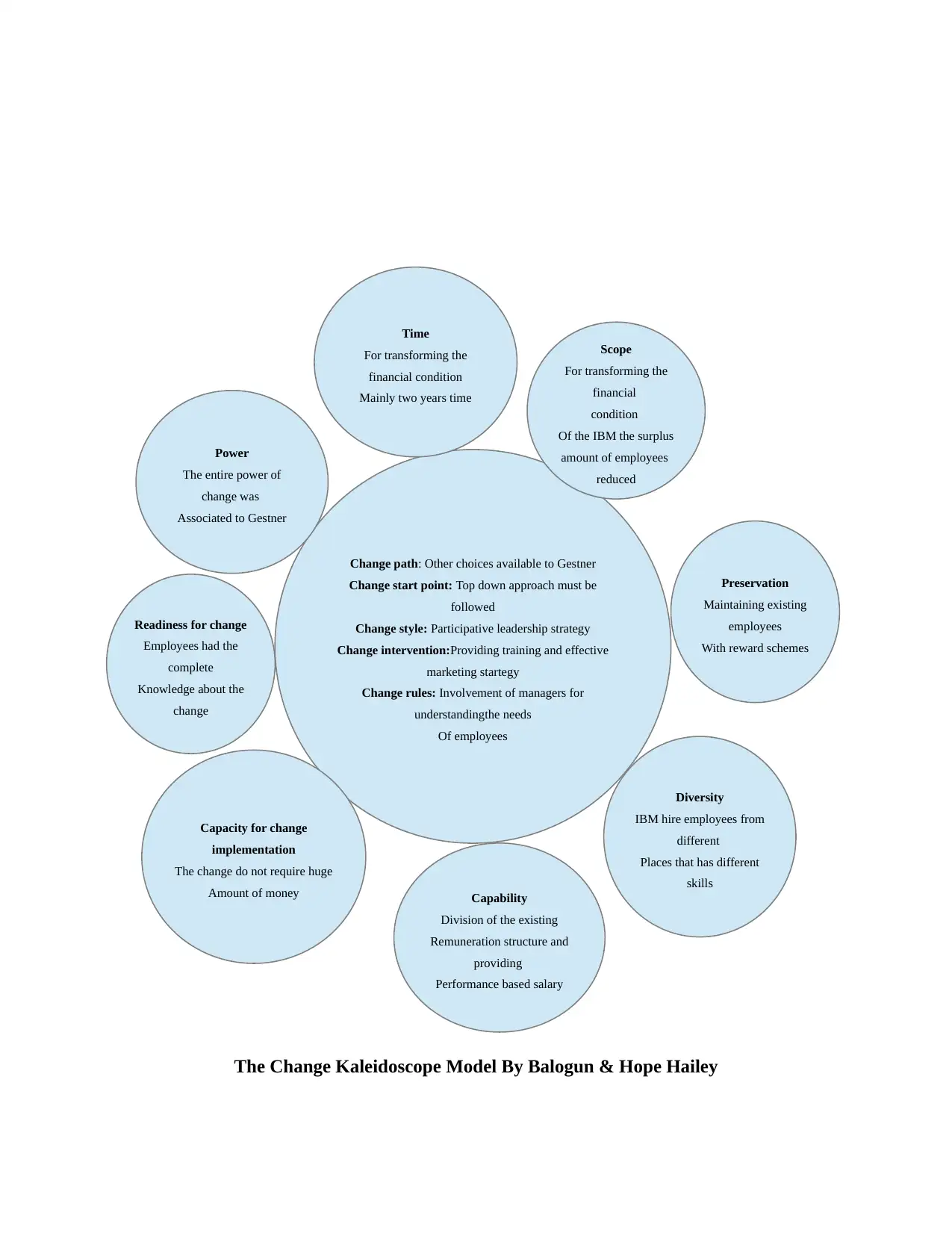
The Change Kaleidoscope Model By Balogun & Hope Hailey
Change path: Other choices available to Gestner
Change start point: Top down approach must be
followed
Change style: Participative leadership strategy
Change intervention:Providing training and effective
marketing startegy
Change rules: Involvement of managers for
understandingthe needs
Of employees
Time
For transforming the
financial condition
Mainly two years time
Scope
For transforming the
financial
condition
Of the IBM the surplus
amount of employees
reduced
Preservation
Maintaining existing
employees
With reward schemes
Diversity
IBM hire employees from
different
Places that has different
skills
Capability
Division of the existing
Remuneration structure and
providing
Performance based salary
Capacity for change
implementation
The change do not require huge
Amount of money
Readiness for change
Employees had the
complete
Knowledge about the
change
Power
The entire power of
change was
Associated to Gestner
Change path: Other choices available to Gestner
Change start point: Top down approach must be
followed
Change style: Participative leadership strategy
Change intervention:Providing training and effective
marketing startegy
Change rules: Involvement of managers for
understandingthe needs
Of employees
Time
For transforming the
financial condition
Mainly two years time
Scope
For transforming the
financial
condition
Of the IBM the surplus
amount of employees
reduced
Preservation
Maintaining existing
employees
With reward schemes
Diversity
IBM hire employees from
different
Places that has different
skills
Capability
Division of the existing
Remuneration structure and
providing
Performance based salary
Capacity for change
implementation
The change do not require huge
Amount of money
Readiness for change
Employees had the
complete
Knowledge about the
change
Power
The entire power of
change was
Associated to Gestner
Paraphrase This Document
Need a fresh take? Get an instant paraphrase of this document with our AI Paraphraser
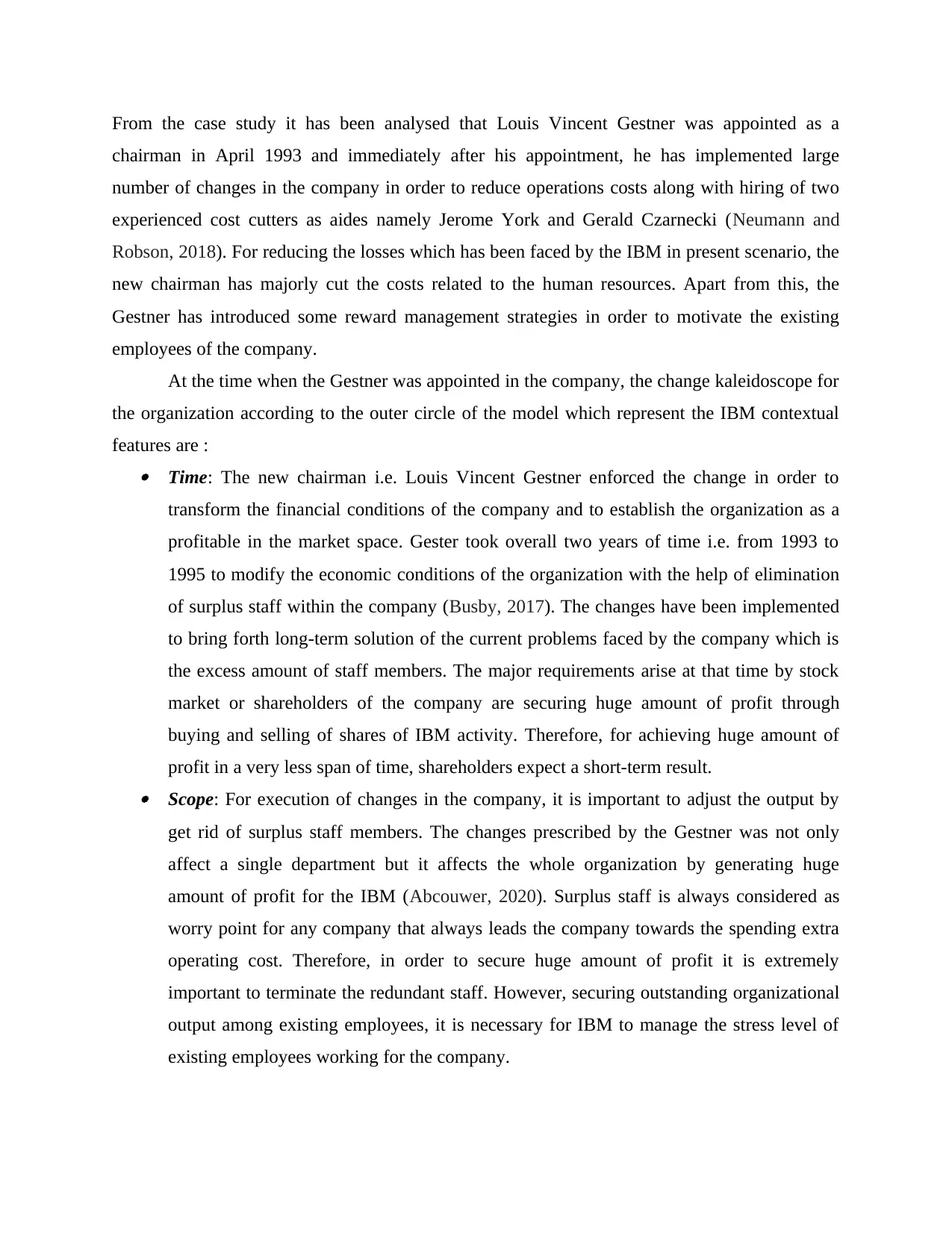
From the case study it has been analysed that Louis Vincent Gestner was appointed as a
chairman in April 1993 and immediately after his appointment, he has implemented large
number of changes in the company in order to reduce operations costs along with hiring of two
experienced cost cutters as aides namely Jerome York and Gerald Czarnecki (Neumann and
Robson, 2018). For reducing the losses which has been faced by the IBM in present scenario, the
new chairman has majorly cut the costs related to the human resources. Apart from this, the
Gestner has introduced some reward management strategies in order to motivate the existing
employees of the company.
At the time when the Gestner was appointed in the company, the change kaleidoscope for
the organization according to the outer circle of the model which represent the IBM contextual
features are : Time: The new chairman i.e. Louis Vincent Gestner enforced the change in order to
transform the financial conditions of the company and to establish the organization as a
profitable in the market space. Gester took overall two years of time i.e. from 1993 to
1995 to modify the economic conditions of the organization with the help of elimination
of surplus staff within the company (Busby, 2017). The changes have been implemented
to bring forth long-term solution of the current problems faced by the company which is
the excess amount of staff members. The major requirements arise at that time by stock
market or shareholders of the company are securing huge amount of profit through
buying and selling of shares of IBM activity. Therefore, for achieving huge amount of
profit in a very less span of time, shareholders expect a short-term result. Scope: For execution of changes in the company, it is important to adjust the output by
get rid of surplus staff members. The changes prescribed by the Gestner was not only
affect a single department but it affects the whole organization by generating huge
amount of profit for the IBM (Abcouwer, 2020). Surplus staff is always considered as
worry point for any company that always leads the company towards the spending extra
operating cost. Therefore, in order to secure huge amount of profit it is extremely
important to terminate the redundant staff. However, securing outstanding organizational
output among existing employees, it is necessary for IBM to manage the stress level of
existing employees working for the company.
chairman in April 1993 and immediately after his appointment, he has implemented large
number of changes in the company in order to reduce operations costs along with hiring of two
experienced cost cutters as aides namely Jerome York and Gerald Czarnecki (Neumann and
Robson, 2018). For reducing the losses which has been faced by the IBM in present scenario, the
new chairman has majorly cut the costs related to the human resources. Apart from this, the
Gestner has introduced some reward management strategies in order to motivate the existing
employees of the company.
At the time when the Gestner was appointed in the company, the change kaleidoscope for
the organization according to the outer circle of the model which represent the IBM contextual
features are : Time: The new chairman i.e. Louis Vincent Gestner enforced the change in order to
transform the financial conditions of the company and to establish the organization as a
profitable in the market space. Gester took overall two years of time i.e. from 1993 to
1995 to modify the economic conditions of the organization with the help of elimination
of surplus staff within the company (Busby, 2017). The changes have been implemented
to bring forth long-term solution of the current problems faced by the company which is
the excess amount of staff members. The major requirements arise at that time by stock
market or shareholders of the company are securing huge amount of profit through
buying and selling of shares of IBM activity. Therefore, for achieving huge amount of
profit in a very less span of time, shareholders expect a short-term result. Scope: For execution of changes in the company, it is important to adjust the output by
get rid of surplus staff members. The changes prescribed by the Gestner was not only
affect a single department but it affects the whole organization by generating huge
amount of profit for the IBM (Abcouwer, 2020). Surplus staff is always considered as
worry point for any company that always leads the company towards the spending extra
operating cost. Therefore, in order to secure huge amount of profit it is extremely
important to terminate the redundant staff. However, securing outstanding organizational
output among existing employees, it is necessary for IBM to manage the stress level of
existing employees working for the company.
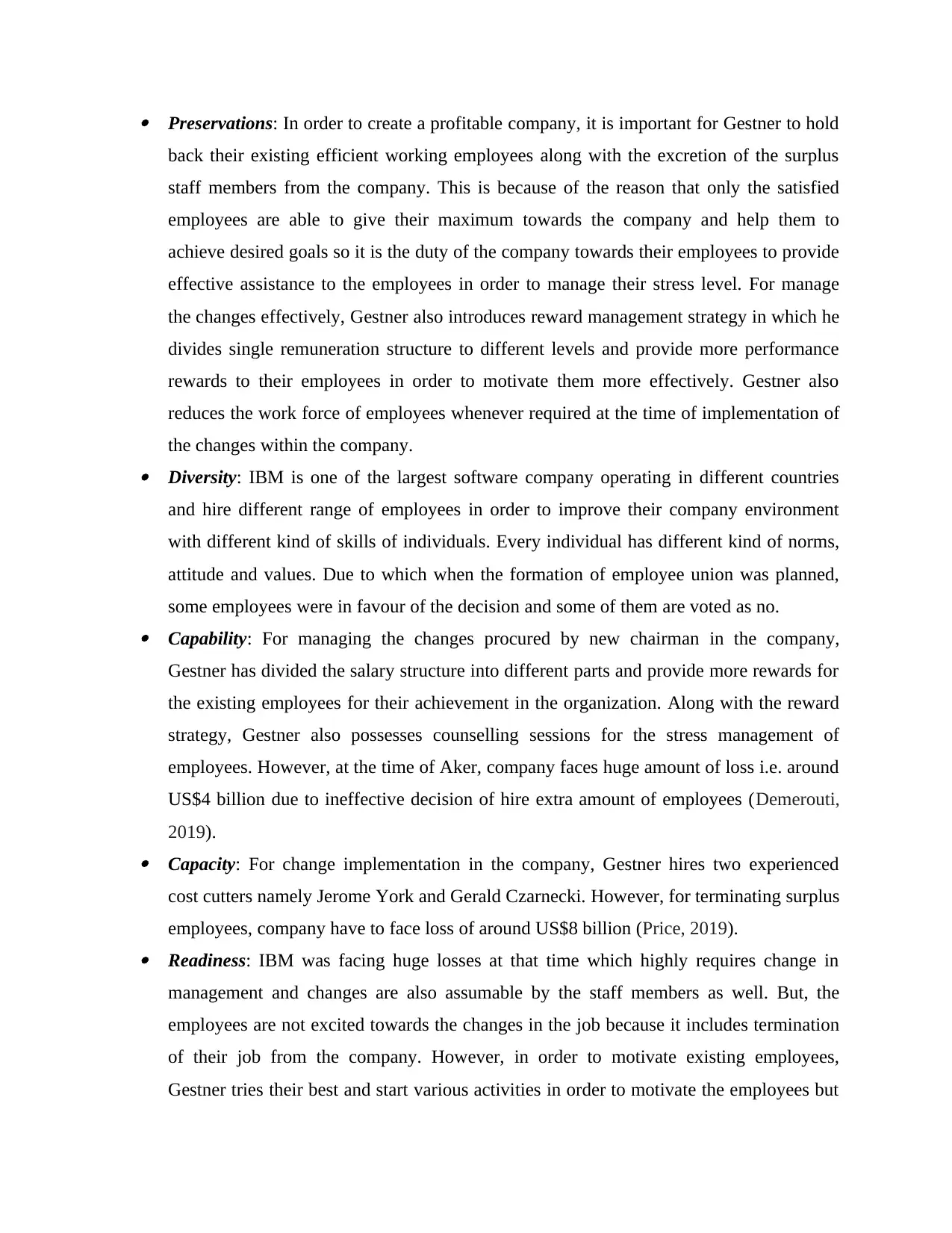
Preservations: In order to create a profitable company, it is important for Gestner to hold
back their existing efficient working employees along with the excretion of the surplus
staff members from the company. This is because of the reason that only the satisfied
employees are able to give their maximum towards the company and help them to
achieve desired goals so it is the duty of the company towards their employees to provide
effective assistance to the employees in order to manage their stress level. For manage
the changes effectively, Gestner also introduces reward management strategy in which he
divides single remuneration structure to different levels and provide more performance
rewards to their employees in order to motivate them more effectively. Gestner also
reduces the work force of employees whenever required at the time of implementation of
the changes within the company. Diversity: IBM is one of the largest software company operating in different countries
and hire different range of employees in order to improve their company environment
with different kind of skills of individuals. Every individual has different kind of norms,
attitude and values. Due to which when the formation of employee union was planned,
some employees were in favour of the decision and some of them are voted as no. Capability: For managing the changes procured by new chairman in the company,
Gestner has divided the salary structure into different parts and provide more rewards for
the existing employees for their achievement in the organization. Along with the reward
strategy, Gestner also possesses counselling sessions for the stress management of
employees. However, at the time of Aker, company faces huge amount of loss i.e. around
US$4 billion due to ineffective decision of hire extra amount of employees (Demerouti,
2019). Capacity: For change implementation in the company, Gestner hires two experienced
cost cutters namely Jerome York and Gerald Czarnecki. However, for terminating surplus
employees, company have to face loss of around US$8 billion (Price, 2019). Readiness: IBM was facing huge losses at that time which highly requires change in
management and changes are also assumable by the staff members as well. But, the
employees are not excited towards the changes in the job because it includes termination
of their job from the company. However, in order to motivate existing employees,
Gestner tries their best and start various activities in order to motivate the employees but
back their existing efficient working employees along with the excretion of the surplus
staff members from the company. This is because of the reason that only the satisfied
employees are able to give their maximum towards the company and help them to
achieve desired goals so it is the duty of the company towards their employees to provide
effective assistance to the employees in order to manage their stress level. For manage
the changes effectively, Gestner also introduces reward management strategy in which he
divides single remuneration structure to different levels and provide more performance
rewards to their employees in order to motivate them more effectively. Gestner also
reduces the work force of employees whenever required at the time of implementation of
the changes within the company. Diversity: IBM is one of the largest software company operating in different countries
and hire different range of employees in order to improve their company environment
with different kind of skills of individuals. Every individual has different kind of norms,
attitude and values. Due to which when the formation of employee union was planned,
some employees were in favour of the decision and some of them are voted as no. Capability: For managing the changes procured by new chairman in the company,
Gestner has divided the salary structure into different parts and provide more rewards for
the existing employees for their achievement in the organization. Along with the reward
strategy, Gestner also possesses counselling sessions for the stress management of
employees. However, at the time of Aker, company faces huge amount of loss i.e. around
US$4 billion due to ineffective decision of hire extra amount of employees (Demerouti,
2019). Capacity: For change implementation in the company, Gestner hires two experienced
cost cutters namely Jerome York and Gerald Czarnecki. However, for terminating surplus
employees, company have to face loss of around US$8 billion (Price, 2019). Readiness: IBM was facing huge losses at that time which highly requires change in
management and changes are also assumable by the staff members as well. But, the
employees are not excited towards the changes in the job because it includes termination
of their job from the company. However, in order to motivate existing employees,
Gestner tries their best and start various activities in order to motivate the employees but
⊘ This is a preview!⊘
Do you want full access?
Subscribe today to unlock all pages.

Trusted by 1+ million students worldwide
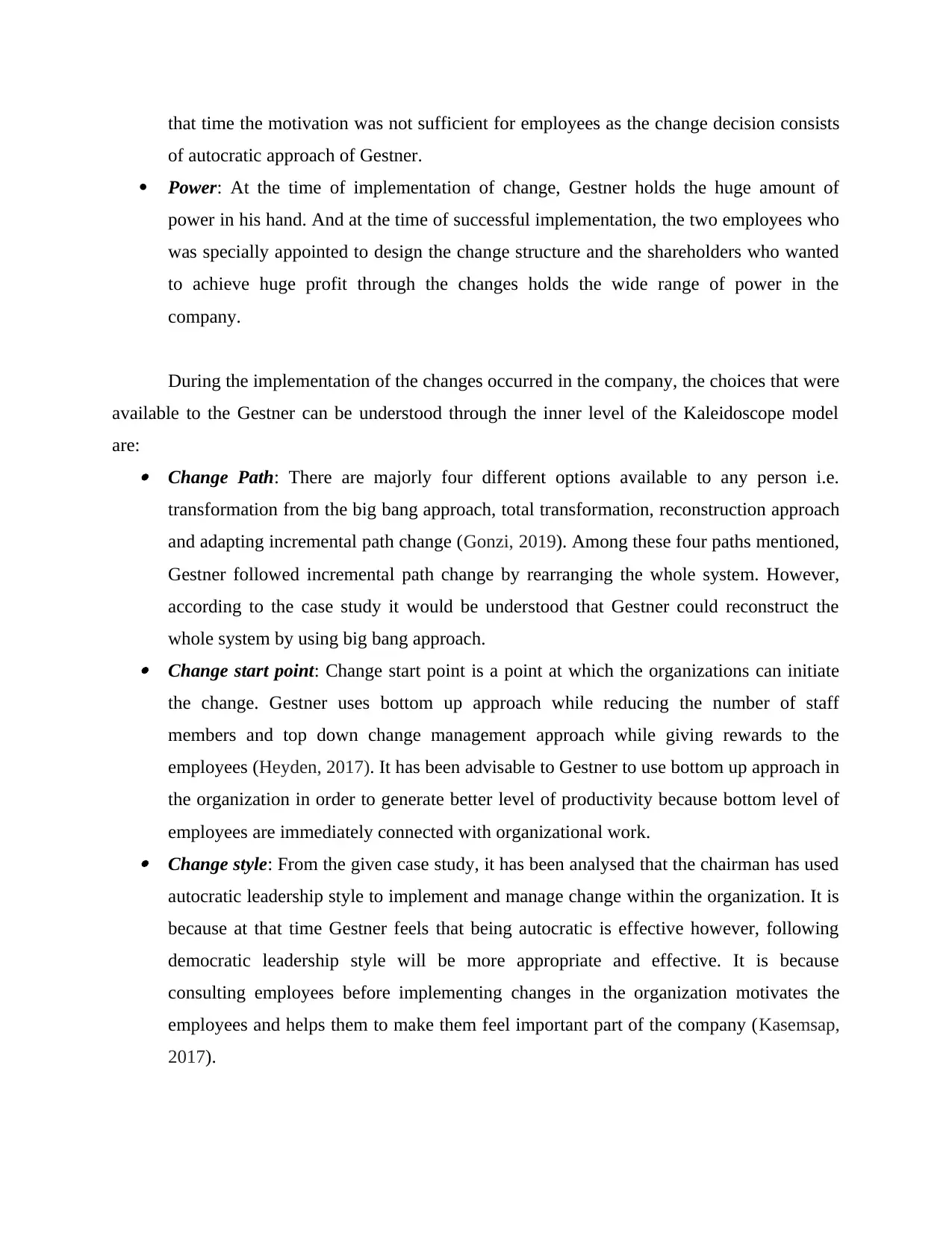
that time the motivation was not sufficient for employees as the change decision consists
of autocratic approach of Gestner.
Power: At the time of implementation of change, Gestner holds the huge amount of
power in his hand. And at the time of successful implementation, the two employees who
was specially appointed to design the change structure and the shareholders who wanted
to achieve huge profit through the changes holds the wide range of power in the
company.
During the implementation of the changes occurred in the company, the choices that were
available to the Gestner can be understood through the inner level of the Kaleidoscope model
are: Change Path: There are majorly four different options available to any person i.e.
transformation from the big bang approach, total transformation, reconstruction approach
and adapting incremental path change (Gonzi, 2019). Among these four paths mentioned,
Gestner followed incremental path change by rearranging the whole system. However,
according to the case study it would be understood that Gestner could reconstruct the
whole system by using big bang approach. Change start point: Change start point is a point at which the organizations can initiate
the change. Gestner uses bottom up approach while reducing the number of staff
members and top down change management approach while giving rewards to the
employees (Heyden, 2017). It has been advisable to Gestner to use bottom up approach in
the organization in order to generate better level of productivity because bottom level of
employees are immediately connected with organizational work. Change style: From the given case study, it has been analysed that the chairman has used
autocratic leadership style to implement and manage change within the organization. It is
because at that time Gestner feels that being autocratic is effective however, following
democratic leadership style will be more appropriate and effective. It is because
consulting employees before implementing changes in the organization motivates the
employees and helps them to make them feel important part of the company (Kasemsap,
2017).
of autocratic approach of Gestner.
Power: At the time of implementation of change, Gestner holds the huge amount of
power in his hand. And at the time of successful implementation, the two employees who
was specially appointed to design the change structure and the shareholders who wanted
to achieve huge profit through the changes holds the wide range of power in the
company.
During the implementation of the changes occurred in the company, the choices that were
available to the Gestner can be understood through the inner level of the Kaleidoscope model
are: Change Path: There are majorly four different options available to any person i.e.
transformation from the big bang approach, total transformation, reconstruction approach
and adapting incremental path change (Gonzi, 2019). Among these four paths mentioned,
Gestner followed incremental path change by rearranging the whole system. However,
according to the case study it would be understood that Gestner could reconstruct the
whole system by using big bang approach. Change start point: Change start point is a point at which the organizations can initiate
the change. Gestner uses bottom up approach while reducing the number of staff
members and top down change management approach while giving rewards to the
employees (Heyden, 2017). It has been advisable to Gestner to use bottom up approach in
the organization in order to generate better level of productivity because bottom level of
employees are immediately connected with organizational work. Change style: From the given case study, it has been analysed that the chairman has used
autocratic leadership style to implement and manage change within the organization. It is
because at that time Gestner feels that being autocratic is effective however, following
democratic leadership style will be more appropriate and effective. It is because
consulting employees before implementing changes in the organization motivates the
employees and helps them to make them feel important part of the company (Kasemsap,
2017).
Paraphrase This Document
Need a fresh take? Get an instant paraphrase of this document with our AI Paraphraser
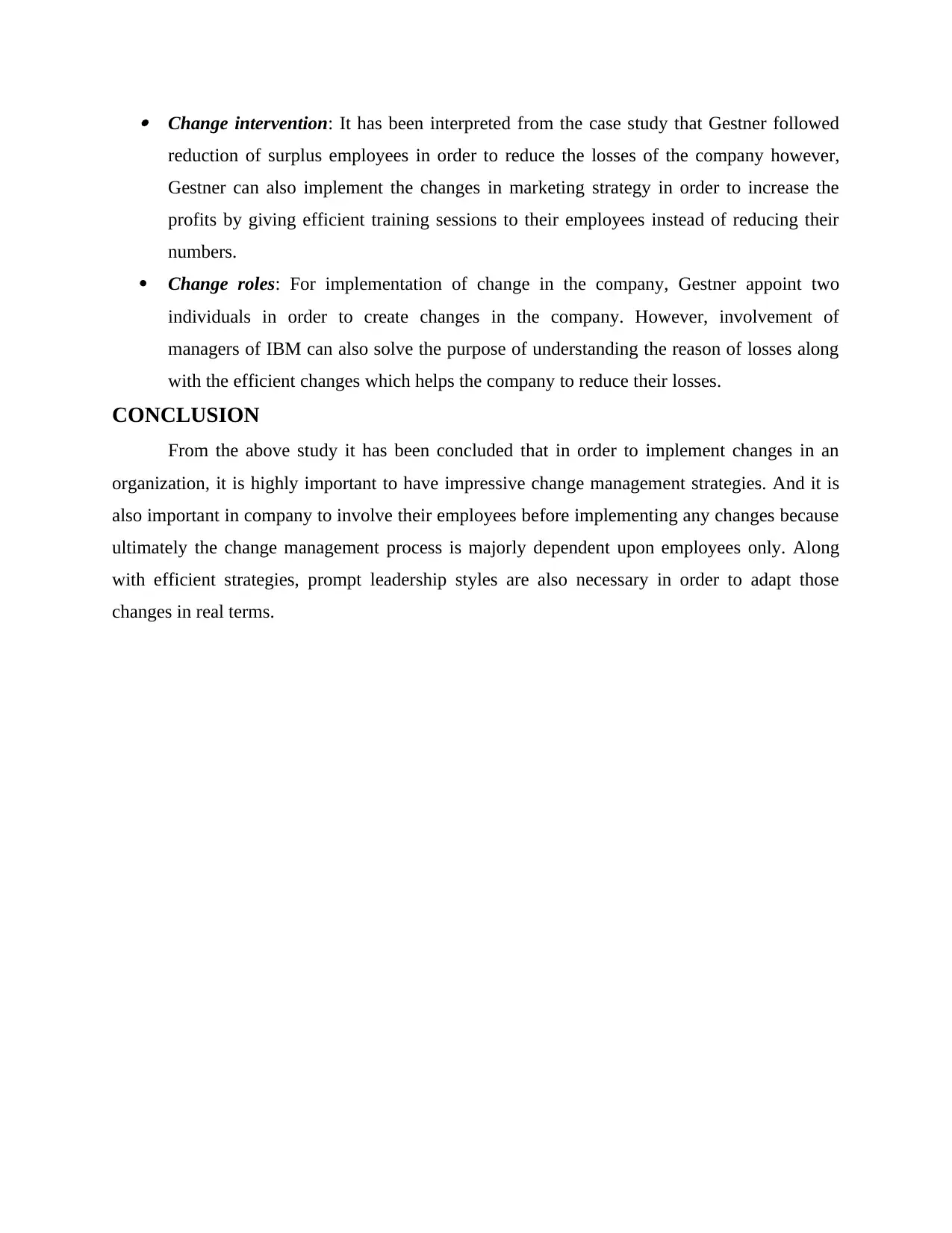
Change intervention: It has been interpreted from the case study that Gestner followed
reduction of surplus employees in order to reduce the losses of the company however,
Gestner can also implement the changes in marketing strategy in order to increase the
profits by giving efficient training sessions to their employees instead of reducing their
numbers.
Change roles: For implementation of change in the company, Gestner appoint two
individuals in order to create changes in the company. However, involvement of
managers of IBM can also solve the purpose of understanding the reason of losses along
with the efficient changes which helps the company to reduce their losses.
CONCLUSION
From the above study it has been concluded that in order to implement changes in an
organization, it is highly important to have impressive change management strategies. And it is
also important in company to involve their employees before implementing any changes because
ultimately the change management process is majorly dependent upon employees only. Along
with efficient strategies, prompt leadership styles are also necessary in order to adapt those
changes in real terms.
reduction of surplus employees in order to reduce the losses of the company however,
Gestner can also implement the changes in marketing strategy in order to increase the
profits by giving efficient training sessions to their employees instead of reducing their
numbers.
Change roles: For implementation of change in the company, Gestner appoint two
individuals in order to create changes in the company. However, involvement of
managers of IBM can also solve the purpose of understanding the reason of losses along
with the efficient changes which helps the company to reduce their losses.
CONCLUSION
From the above study it has been concluded that in order to implement changes in an
organization, it is highly important to have impressive change management strategies. And it is
also important in company to involve their employees before implementing any changes because
ultimately the change management process is majorly dependent upon employees only. Along
with efficient strategies, prompt leadership styles are also necessary in order to adapt those
changes in real terms.
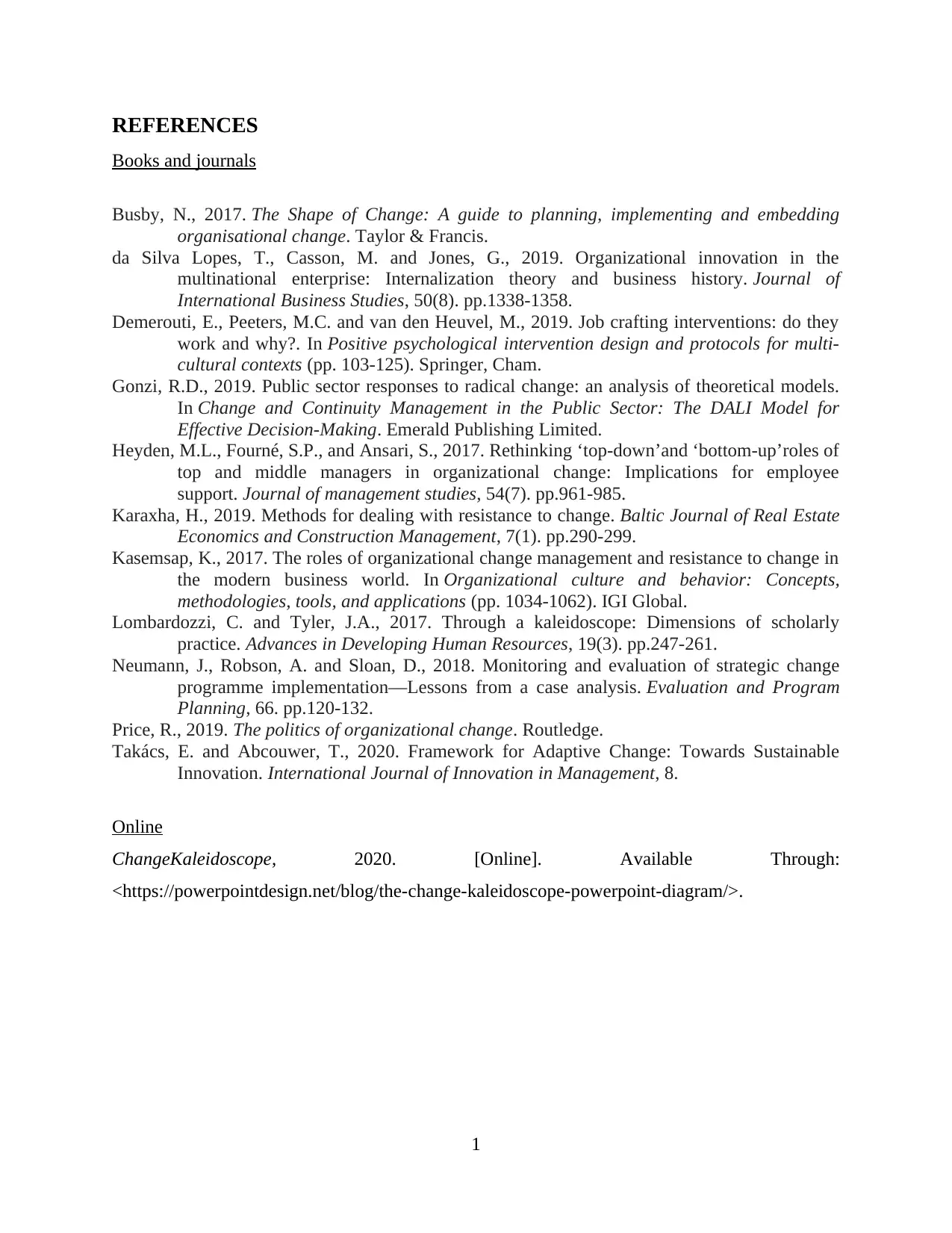
REFERENCES
Books and journals
Busby, N., 2017. The Shape of Change: A guide to planning, implementing and embedding
organisational change. Taylor & Francis.
da Silva Lopes, T., Casson, M. and Jones, G., 2019. Organizational innovation in the
multinational enterprise: Internalization theory and business history. Journal of
International Business Studies, 50(8). pp.1338-1358.
Demerouti, E., Peeters, M.C. and van den Heuvel, M., 2019. Job crafting interventions: do they
work and why?. In Positive psychological intervention design and protocols for multi-
cultural contexts (pp. 103-125). Springer, Cham.
Gonzi, R.D., 2019. Public sector responses to radical change: an analysis of theoretical models.
In Change and Continuity Management in the Public Sector: The DALI Model for
Effective Decision-Making. Emerald Publishing Limited.
Heyden, M.L., Fourné, S.P., and Ansari, S., 2017. Rethinking ‘top‐down’and ‘bottom‐up’roles of
top and middle managers in organizational change: Implications for employee
support. Journal of management studies, 54(7). pp.961-985.
Karaxha, H., 2019. Methods for dealing with resistance to change. Baltic Journal of Real Estate
Economics and Construction Management, 7(1). pp.290-299.
Kasemsap, K., 2017. The roles of organizational change management and resistance to change in
the modern business world. In Organizational culture and behavior: Concepts,
methodologies, tools, and applications (pp. 1034-1062). IGI Global.
Lombardozzi, C. and Tyler, J.A., 2017. Through a kaleidoscope: Dimensions of scholarly
practice. Advances in Developing Human Resources, 19(3). pp.247-261.
Neumann, J., Robson, A. and Sloan, D., 2018. Monitoring and evaluation of strategic change
programme implementation—Lessons from a case analysis. Evaluation and Program
Planning, 66. pp.120-132.
Price, R., 2019. The politics of organizational change. Routledge.
Takács, E. and Abcouwer, T., 2020. Framework for Adaptive Change: Towards Sustainable
Innovation. International Journal of Innovation in Management, 8.
Online
ChangeKaleidoscope, 2020. [Online]. Available Through:
<https://powerpointdesign.net/blog/the-change-kaleidoscope-powerpoint-diagram/>.
1
Books and journals
Busby, N., 2017. The Shape of Change: A guide to planning, implementing and embedding
organisational change. Taylor & Francis.
da Silva Lopes, T., Casson, M. and Jones, G., 2019. Organizational innovation in the
multinational enterprise: Internalization theory and business history. Journal of
International Business Studies, 50(8). pp.1338-1358.
Demerouti, E., Peeters, M.C. and van den Heuvel, M., 2019. Job crafting interventions: do they
work and why?. In Positive psychological intervention design and protocols for multi-
cultural contexts (pp. 103-125). Springer, Cham.
Gonzi, R.D., 2019. Public sector responses to radical change: an analysis of theoretical models.
In Change and Continuity Management in the Public Sector: The DALI Model for
Effective Decision-Making. Emerald Publishing Limited.
Heyden, M.L., Fourné, S.P., and Ansari, S., 2017. Rethinking ‘top‐down’and ‘bottom‐up’roles of
top and middle managers in organizational change: Implications for employee
support. Journal of management studies, 54(7). pp.961-985.
Karaxha, H., 2019. Methods for dealing with resistance to change. Baltic Journal of Real Estate
Economics and Construction Management, 7(1). pp.290-299.
Kasemsap, K., 2017. The roles of organizational change management and resistance to change in
the modern business world. In Organizational culture and behavior: Concepts,
methodologies, tools, and applications (pp. 1034-1062). IGI Global.
Lombardozzi, C. and Tyler, J.A., 2017. Through a kaleidoscope: Dimensions of scholarly
practice. Advances in Developing Human Resources, 19(3). pp.247-261.
Neumann, J., Robson, A. and Sloan, D., 2018. Monitoring and evaluation of strategic change
programme implementation—Lessons from a case analysis. Evaluation and Program
Planning, 66. pp.120-132.
Price, R., 2019. The politics of organizational change. Routledge.
Takács, E. and Abcouwer, T., 2020. Framework for Adaptive Change: Towards Sustainable
Innovation. International Journal of Innovation in Management, 8.
Online
ChangeKaleidoscope, 2020. [Online]. Available Through:
<https://powerpointdesign.net/blog/the-change-kaleidoscope-powerpoint-diagram/>.
1
⊘ This is a preview!⊘
Do you want full access?
Subscribe today to unlock all pages.

Trusted by 1+ million students worldwide
1 out of 9
Related Documents
Your All-in-One AI-Powered Toolkit for Academic Success.
+13062052269
info@desklib.com
Available 24*7 on WhatsApp / Email
![[object Object]](/_next/static/media/star-bottom.7253800d.svg)
Unlock your academic potential
Copyright © 2020–2025 A2Z Services. All Rights Reserved. Developed and managed by ZUCOL.



